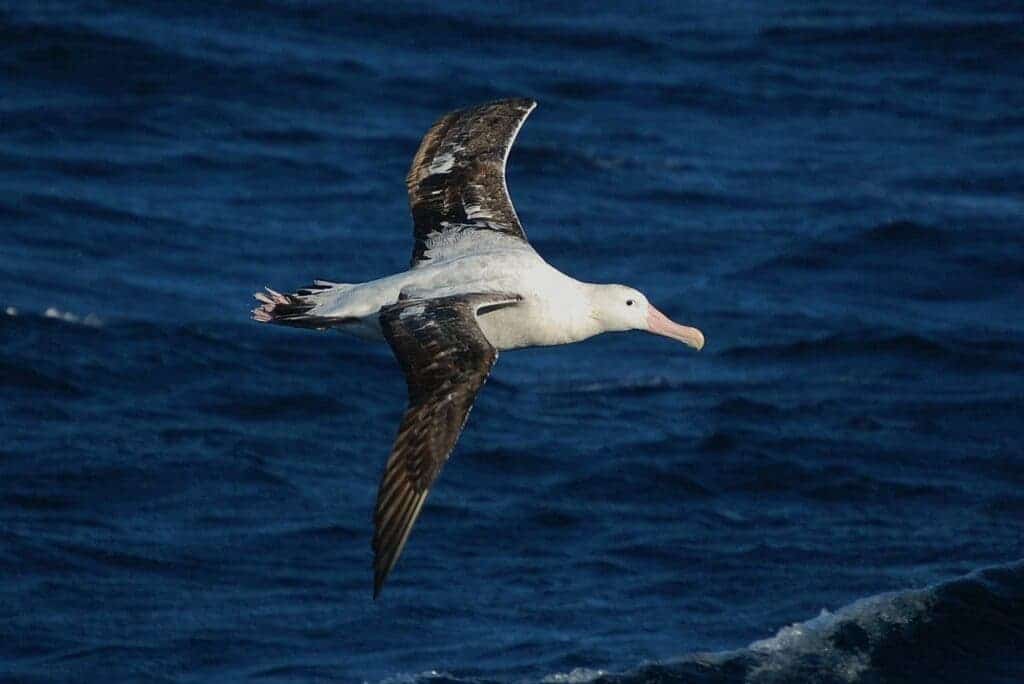In the albatross dating scene, shy males are more likely to get dumped, say researchers at the Woods Hole Oceanographic Institution.

Wandering Albatrosses (Diomedea exulans) live their lives soaring above the oceans in the Southern Hemisphere. Such a lifestyle has bred them to have large, energy-efficient wings; they have the largest wingspan of any bird, at over 10 ft (3 m) in length. But it also leaves precious little time for dating. So most albatrosses form stable, lifelong couples with a single mate, showing one of the most pronounced degrees of monogamy in all wild species.
As is the case in other parts of life, sometimes, things don’t work out in albatross ‘marriages’. New research is exploring whether and how the different personality types of male birds can influence the odds of such a break-up happening.
Too shy for comfort
Conflict-averse males, the team found, are more likely to get dumped by their mates. This is the first time that personality has been shown to be a reliable predictor of a breeding pair’s ‘divorce’ in wild animals.
Although these albatrosses spend much of their life gliding over the ocean, they do meet up once every two years to breed with their chosen partner. That being said, “if they find that their breeding success is too low with a specific partner they may look for another one,” explains Ruijiao Sun, a Ph.D. student at Woods Hole Oceanographic Institution in the US and lead author of the paper. Such a ‘divorce’ event is pretty rarely seen, only occurring in around 13% of couples, according to the study.
In order to better understand what elements contribute to a couple engaging in such a divorce, the researchers drew on a unique database in order to better understand the personalities of different birds.
This dataset has been put together by researchers tracking a colony of wandering albatrosses on Possession Island in Crozet archipelago in the southern Indian Ocean, an effort that has been ongoing since 1959.
“We put a stainless ring on the leg with a number,” says marine biologist and study co-author Stephanie Jenouvrier in an interview for AFP. “Because they’re not really scared we can approach very slowly and we can read the number, [allowing us to] reconstruct the entire history of these birds”.
According to Sun, the birds breed every two years as they need one year to raise each chick, a very draining process for both parents. They take the second year to recover and don’t spend much time together during that time.
The team measured the boldness of almost 2,000 birds by using their response to humans approaching their nest as a proxy. Then, they compared this metric with each bird’s history of divorce.
All in all, the team found that male albatrosses that were below average in boldness — i.e. they were more avoidant of conflict / shyer — were almost twice as likely to be dumped by their mate than those who were above average in boldness.
“We show for the first time the link between personality and divorce in a wild species, thanks to probably the best dataset in the world,” Sun said.
The team also explains that these birds employ elaborate courtship steps, which also involve the males putting up a show for the females they are interested in by raising their wings, squawking, and doing a dance. Males can sometimes try to step in on the displays of males that are already in a pair. It is more likely that the outsider male is higher in boldness, as this is an aggressive act. If the male being interrupted is more risk averse, it may simply concede the dance to avoid confrontation, and thus de-facto accepting being ‘divorced’ from their mate.
That being said, there are other factors influencing the rate of divorce in a given colony. For example, there tend to be more male albatrosses than females, as females tend to forage for food in open areas where they are more likely to get caught up in fishing equipment. As such, females are quick to find new mates, whereas males can spend upwards of four years looking for a new pair.
Furthermore, individuals that have been paired up for a long time are less likely to break up than new pairs, according to the authors. Climate change could also be contributing to the rising rate of divorce seen in albatross colonies, as it places extra stress on the pairs to find adequate food and shelter.
The paper “Boldness predicts divorce rates in wandering albatrosses (Diomedea exulans)” has been published in the journal Biology Letters.


